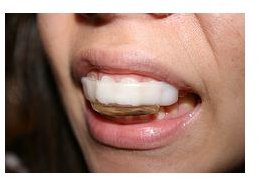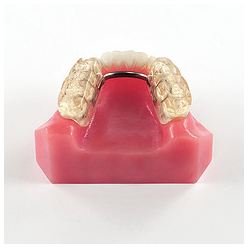Different Splints Used to Treat TMJ
There are different splints used to treat TMJ. Splints allow the muscles and ligaments to relax and relieve the facial muscles of tension and tightness. If the patient grinds their teeth it can protect the patient from more wear of the teeth. If the patients bite is off or incorrect, a splint can adjust the bite into an optimum position. All splints need to be continually adjusted in order to help.
An important step is to be evaluated by a qualified dentist dealing with TMJ. With today’s sophisticated computer equipment, they are able to determine the type of TMJ problem and provide the correct treatment plan suited specifically to your needs.
Images

Types of Splints
Most common is a full upper mouth (bite plate) guard or splint. It is constructed to your mouths exact specifications by your dentist. It fits over all the upper teeth. It holds the jaw in a more comfortable position during sleep, while reducing jaw clenching and teeth grinding.
A mandibular repositioning mouth guard device can be worn a short time to help alleviate symptoms related to painful clicking, however, 24 hour wear can lead to changes in the positioning of the teeth. This should be worn at night during sleep only.
A stabilization splint is flat and covers all of the teeth. It is usually worn to prevent clenching of the jaw and is made from either soft or hard materials.
A repositioning splint is used to move the lower jaw either forward or back, changing the bite permanently. It is a more invasive form of splint treatment. This splint positions a patients jaw into a position based on an Xray analysis and muscle testing. It needs to be worn constantly and needs to be adjusted once a month. Most cases (75 percent of patients) require physical therapy and postural education before the appliance can succeed.
Conclusion
Here are some questions you might want to ask your dentist during your consultation:
What are my options?
What will the splint do?
What proof do you have that this splint will help?
Is the splint worn day, night or 24 hours?
How long will I wear the splint before noticing an improvement?
If the splint doesn’t work, what will be the next step?
Some patients do not experience pain relief with splint therapy alone. Some will also need physical therapy, massage therapy, injections of cortisones, pain medications or surgery. Not all cases are the same. The use of a splint should be discontinued if it is painful or increases your pain.
References
21st Centruy Dental: https://www.21stcenturydental.com/smith/book/3rd_sth.htm
Dental Health Directory: https://www.dental–health.com/tmjtmd_appliances.html
Photo’s courtesy of Flickr.com:
https://www.flickr.com/photos/unrealism2009/4564329011/ by unrealism2007
https://www.flickr.com/photos/isobellies/170402688/ by isobellies
